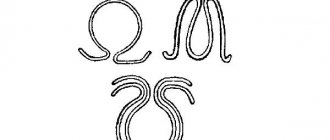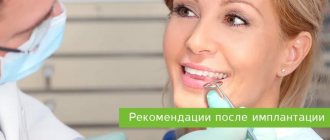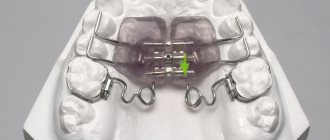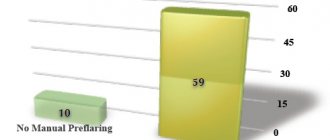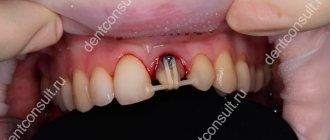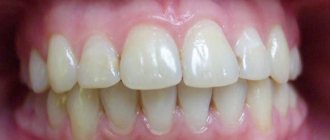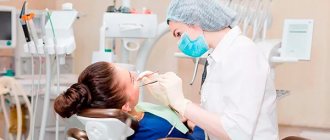Unfortunately, not all dental defects are corrected with the help of braces, mouth guards and aligners. Quite often, patients experience pathologies, the elimination of which requires the use of more radical measures. This occurs in cases where the cause of malocclusion is not individual dental units, but a disproportion in the development of the upper and lower jaws.
A palatal expander is an orthodontic device that is intended to correct abnormalities in the development of the upper jaw.
Design features of the palatal expander
A palatal expander is a metal orthodontic structure that has:
- support rings (crowns) - placed on molars;
- screw - designed to expand the device;
- wire arches - connected to supporting elements and a lock, creating a shock-absorbing effect of the structure.
Due to the constant pressure of the device on the lateral parts of the upper jaw, they quickly stretch.
Advantages and disadvantages of a palatal expander
Orthodontic construction has a number of advantages. These include:
- short active treatment period - it takes only a few weeks to correct the pathology;
- the ability to accurately predict the final result;
- expansion of the jaw does not entail a change in the position of the roots of the teeth, but allows them to remain in the same sockets without provoking;
- the design of the product is highly safe - the likelihood of injury to the oral mucosa due to device failure is excluded;
- high aesthetics - the device is invisible to others.
The negative points are the following:
- despite its high aesthetics, the palatal expander is a bulky orthodontic structure;
- the surface of the tongue is subject to a high probability of mechanical damage by the locking mechanism of the product;
- the adaptation period is accompanied by impaired swallowing function;
- presence of excessive salivation;
- pronounced articulatory disorders;
- the active period of treatment is accompanied by painful sensations.
Many patients are consoled by the fact that the discomfort associated with the use of a palatal expander does not have to be endured for long.
Facial Aesthetics and Patient Health Back
Dr John Flutter, Professor, Queen's University London, Bachelor of Dental Surgery, Oral Surgeon.
“To normalize occlusion and stabilize the results of maxillary expansion, it is necessary to teach the tongue to be located and function in the palatal position...”
Research confirms that harmonious horizontal growth of facial structures is the key to an attractive appearance. A powerful tool for stimulating the horizontal growth vector of the facial skeleton is the tongue. The tongue is the strongest muscle in the body. It is known that the pressure it can exert on the anterior teeth is up to 500 grams 1. This force must be directed upward and forward towards the anterior teeth of the upper jaw in order to:
1. form the upper jaw of the correct size and shape with sufficient space for all permanent teeth;
2. stimulate the horizontal growth vector of the facial skeleton.
Statistical research in Australia has found that around 75% of young Australians have crowded teeth. What are the causes of the problem and what can we do about it? In Plusk, the vertical type of growth of the facial skeleton predominates. The strength of the muscles of the tongue and lips affects the position of the teeth, moving them into the correct position when there is dysfunction of the soft tissues surrounding the dentition.
Five main factors influence normal maxillofacial development:
1. closed position of the lips at rest;
2. the teeth are slightly open at rest;
3. palatal position of the tongue at rest and during swallowing;
4. breathing through the nose;
5. lack of tension in the perioral muscles when swallowing.
Research confirms that in most cases, orthodontic treatment used to straighten teeth results in vertical facial growth. It is also known that vertical growth of facial structures does not contribute to the formation of an attractive appearance.
Maxillary expansion
Many years of scientific research and clinical experience have convincingly proven that after expansion of the jaw arch, a relapse usually occurs - after a few years, the jaws often return to their original shape and size. However, this does not always happen.
To widen the jaws to relieve crowding 25 years ago, I used the methods and apparatus of Dr. Skip Truitt, whose lectures I attended at the time. I will show you the first case of jaw expansion in my clinical practice, which I recorded in the photo (Fig. 1-5). In this case, I expanded the upper jaw with a Schwarz Plate orthodontic plate, and the lower jaw with a Jackson apparatus. (I wouldn't use either of these devices today). So it took me about 18 months to correct my bilateral crossbite. Many years later, I saw this patient again and noted that the achieved expansion was not only maintained, but, without any further treatment, the patient had significantly improved occlusion (Fig. 6-7). This had never happened before in my early practice.
Rice. 1-4. Before and after 18 months of expansion (treatment started at 7 years old) . Against the background of expansion of the upper dental arch, the width of the nasal passages increased.
In most of the jaw expansion cases I have dealt with, there has been a relapse after a few years. When we expand the upper jaw, growth occurs in the forward direction in the space of the skull. This is especially pronounced in children under eight and a half years of age.
To stimulate forward growth of the maxilla, I used to use a face mask and at that time I often wondered: “Why was the expansion achieved stable in that first case?” At that time, I did not yet have the necessary skills and did not use any devices that affect the functions that I know and use effectively now. Today I realized that the reason for the stable results and improvement of occlusion is the important factor that after expansion of the maxilla, the patient's tongue must be taught to rest in the palatal position at rest and when swallowing. This is a paradox - with a formed narrow upper jaw, there is not enough space in the oral cavity for the normal position and functioning of the tongue. After expansion of the maxilla, if the tongue is not used to positioning and supporting the palate, the width of the maxilla tends to return to its original shape and size.
The shape of the upper jaw after treatment remains stable for life only if, thanks to the palatal position of the tongue at rest, the achieved jaw expansion is supported and stabilized. So, the first thing we should strive for is to ensure normal width and volume of the upper jaw for the correct position of the tongue. Secondly, in order to stabilize the normal size of the jaw, it is necessary to normalize the function of the muscles of the lips and tongue to maintain myodynamic balance - a paradox! I believe that in this patient, before the expansion of the dental arches, oral breathing predominated.
Rice. 5. Before treatment and 18 months after treatment . When the upper jaw expands, it moves forward in the space of the skull. Optimal results can be achieved if the patient is under eight and a half years old.
Rice. 6 (top) and 7. Several years after treatment, jaw expansion was maintained and occlusion was optimized.
As a result of the expansion of the upper jaw, the width of the nasal passages also increases, which in turn helps to restore and normalize nasal breathing. Over the 25 years that have passed since the treatment of this case, I have rethought a lot, and now I am absolutely sure that one cannot count on the fact that immediately after the expansion of the upper dental arch, the tongue will automatically take a palatal position and the patient will spontaneously learn to breathe through the nose. This rarely happens, as evidenced by the prevalence of relapses after maxillary expansion.
Fig 8. Before treatment .
Fig. 9. 1st stage of treatment with the Bioblok dilating apparatus (6 months)
Rice. 10. Stage 2 of treatment: face mask to correct crossbite. The patient wore it 12 hours a day.
Rice. 11. 3rd stage: after 6 months. i -3™ device was prescribed for 1 year .
Figures 8-11 illustrate a case I began treating in September 2007. I diagnosed an anterior and posterior crossbite, which in this case was not the result of prognathism and a large mandible; rather, it was a case of underdevelopment and retrognathic position of the maxilla in the cranial space. At the same time, the tongue was consistently in a lower position, and the patient experienced habitual mouth breathing. At the first stage of treatment, we expanded the upper jaw with the Bioblok device - a palatal plate that is worn 24 hours a day and is removed only to clean the teeth and tighten the screw. The screw was tightened 1/8 turn each day, expanding the dental arch by 7/8 mm per week. This is a medium-fast expansion that allows the midline of the palatal suture to stretch without tearing it. Tightening the screw in this mode leads to less vestibular inclination of the teeth and greater expansion of the palatal suture. In order to tighten the screw in this mode, reliable fixation of the Bioblock device on the dental arch is necessary, which is provided by Crozat clasps. To actively expand the maxilla, the patient wore a face mask for 12 hours a day, mainly during sleep. Once we had widened the maxilla and created sufficient space for the tongue in the resting position, we began to correct myofunctional disorders.
About 15 years ago, I was actively involved in searching and studying effective ways to correct the muscle pattern of the lips and tongue in children in order to correct bad habits and parafunctions to normalize the growth of facial structures and the general health of the child’s body. Considering the five main factors necessary for successful functional correction and stable results of treatment, I tried several different methods of conducting myogymnastics - special exercises for the muscles of the maxillofacial area, which required me to actively cooperate with the child and his parents. On the rare occasions when they followed the prescribed exercises, I saw significant improvements.
Fig. 12. Trainer T 4 K (Trainer for Kids) from MRC, Australia.
About 12 years ago, I began using devices developed by Myofunctional Research Co. to treat patients. (MRC) in Queensland, Australia. These standard devices, called “trainers,” were developed in the early 90s specifically to correct the function of the muscles of the maxillofacial area (Fig. 13).
The main purpose of the trainer is not to move teeth and jaws, but to train the muscles of the lips and tongue, correct myofunctional disorders and form a physiologically correct functional muscle pattern, which helps normalize the development of the dentofacial system.
Rice. 13 . _ Correct position of the tongue at rest and normal nasal breathing (right) .
“The main purpose of the trainer is not to straighten the teeth or widen the jaws, but to reconstruct the functioning of the muscles of the lips and tongue in order to correct myofunctional disorders...”
The trainer provides all five key points that optimize maxillofacial development:
1. lips are closed at rest;
2. teeth are slightly open;
3. the tongue is in the palatal position, the tip of the tongue is at the “SPOT” point;
4. breathing is constantly carried out through the nose;
5. there is no tension in the perioral muscles when swallowing.
So, in order to correct the muscle pattern, I selected the i-32 trainer manufactured by Myofunctional Research Co. (MRC) . The patient wore it with her lips closed 1 hour a day and all night for a year. Additionally, this girl studied according to the program “Postural correction and normalization of breathing” that I specially developed. For the last 15 years I have been working on this program to help children with mouth breathing problems, because... If a child does not learn to breathe through his nose, his tongue will not be positioned palatally, which means he will not be able to maintain the shape and width of the upper jaw achieved during orthodontic treatment. In such patients, relapse is inevitable.
The development of this program was intended to accompany the treatment of children with combined occlusion pathologies and dysfunction of the soft tissues of the maxillofacial area against the background of nasal breathing disorders of various etiologies. You can learn more about this accompanying treatment program on the website orthodonticearlytreatment.com. The site also contains an article that was published in the Journal of the International Association of Orthodontists.
Working in my Australian clinic, the Center for Early Orthodontic Treatment, I developed a program to support the treatment of children with myofunctional disorders, aimed at restoring free nasal breathing (photo 14).
Fig. 14. “Proper Breathing” program. Nasal breathing is a key factor not only for normal maxillofacial development, but also for improving the overall health and proper development of the child’s body.
Rice. 15 . View of the patient’s dental arches after a year of treatment on the i -3™ trainer.
Figure 16 . Changing the patient's profile after jaw expansion and myofunctional correction
Rice. 17-18 . The patient's facial and profile changes demonstrate predominant maxillary growth after just one year of treatment with the MRC .
In 2001-2004 I was involved in a research project at the University of Belfast investigating the corrective effects of MRC devices. Children participating in the study were asked to regularly wear the i-3 or T4K trainers for a year - one hour a day and all night while sleeping, with their lips closed. The results of this study were published in The Journal of Pediatric Dentistry (Volume 31, Number 4/2007) in the article “Changes in dental arch dimensions after treatment with standard functional appliances”2.
According to the results of treatment of one of the patients who participated in our program (Fig. 15-18), one can clearly see the advancement in the space of the skull of both jaws with the simultaneous development and advancement of the orbital area of the eyes.
Thus, the objective data of the above studies confirm that during the period of early mixed dentition, stimulation of the horizontal growth vector of the upper jaw without the use of orthodontic expansion plates can be very effective with a functional approach to treatment. By teaching the child's tongue to take a palatal position when swallowing and at rest, at this age we can stimulate the growth of both jaws upward and forward, which is extremely important for the formation of a harmonious profile in a growing child.
Over the past two decades, I have come to the firm belief that health problems are caused by insufficient growth and development of body structures. And therefore, the role of normalizing the development of facial structures in terms of orthodontic treatment to achieve the best aesthetic result cannot be overestimated. I have learned to recognize underdevelopment of the bone structures of the maxillofacial area, which helps me make correct diagnoses.
Having fully realized the importance of stimulating horizontal growth of the maxillofacial region in patients with early mixed dentition, you will be able to acquire all the necessary knowledge to correctly diagnose maxillofacial growth disorders in children and treat them as effectively as possible.
Literature:
1.Dr. John Flutter BDS (London). The Key to Facial Beauty and Optimal Patient Health – Part 1 , Australasian Dental Practice, 2009.
2. Ramirez-Yañez G, Sidlauskas A, Junior E, Flutter J. Dimensional Changes in Dental Arches After Treatment with a Prefabricated Functional Appliance, The Journal of Pediatric Dentistry Volume 31, Number 4/2007.
3. Ramirez-Yañez GO, Farrell C. – Soft Tissue Dysfunction: A missing clue when treating malocclusions. Int J Jaw Func Orthop (in press) 2005b.
4. Ramirez-Yañez, German O. DDS.
Early Treatment of a Class II, Division 2 Malocclusion with the Trainer for Kids (T4K): A Case Report J Clin Pediatr Dent 32(4): 325–330, 2008. Back
Indications and contraindications
The only indication for installing a palatal expander is a pathological narrowing of the upper jaw - micrognathia.
It can develop due to:
- genetic conditioning;
- disorders of fetal development in the embryonic period;
- disruption of the endocrine system;
- consequences of rickets;
- disorders of mineral metabolism in the human body.
There are contraindications for using a palatal expander.
These include:
- asymmetrical crossbite;
- open bite of anterior teeth;
- the presence of skeletal jaw asymmetry;
- convex profile;
- inflammatory processes in periodontal tissues.
Will braces be needed?
Before starting treatment with the Marco Ross apparatus, it is impossible to say for sure whether further treatment with braces will be needed or not. This depends on the results of correction of disorders and the direction of development of the child’s dental apparatus.
In some cases, if the anomaly is not completely eliminated, braces will be required. In other circumstances, when the violations are completely eliminated, such a need does not arise.
But even if braces are used, treatment with them after correction with the Marco Ross apparatus will be much faster and easier than without it.
In addition, refusal to treat a narrowed upper jaw in childhood can create a situation in which an adult with fully formed teeth will need surgical intervention and the cost of the issue will be many times higher. If possible, it is better to avoid this.
What does the Bruxogard trainer look like and what is its purpose?
This publication provides instructions for using the TMJ joint splint.
Here https://orto-info.ru/sistemyi-vyiravnivaniya-zubov/lechebno-profilakticheskie-apparatyi/ispolzovanie-bidermana.html all the most important things about the Biderman apparatus.
Preparatory stage and installation of a palatal expander
Having examined the patient and drawn up a plan for correcting the pathology, the orthodontist begins preparing the patient for the installation of an orthodontic product.
For this purpose the following is carried out:
- a thorough examination of the patient’s oral cavity and, if necessary, treatment of carious teeth;
- professional hygienic cleaning;
- increasing the distance between the supporting molars using separation rings installed for 7 days.
The palatal expander is installed using two methods:
- directly in the patient’s oral cavity;
- on a plaster model of the patient's jaw.
Support rings can be standard or custom made.
The orthodontic screw is selected by the doctor in accordance with the therapeutic task.
Installation of wire arches is carried out by fixing closed loops with locks of support rings.
Oral hygiene when using the device
The presence of any orthodontic structure in the oral cavity requires the patient to pay increased attention to the condition of the teeth and mucous membrane.
To avoid the development of diseases caused by the accumulation and development of pathogenic microbes on the palatal expander and teeth, it is necessary to use the following hygiene products:
- toothbrush and toothpaste (twice a day);
- use of rinse aid;
- removing food debris using toothpicks, floss, brushes;
- The presence of an irrigator will facilitate the care of the orthodontic product.
Changing the size of the jaw is a physiologically and morally very complex process. If it is not possible to avoid it, then strictly follow the orthodontist’s instructions - this will help shorten the active therapeutic period.
Manifestations of distal bite in the mouth
Closing of lateral teeth during distal occlusion.
Distal occlusion is manifested in the mouth by the closure of the upper and lower teeth according to the “second class” (violation of the relationship between the projections of the antagonist teeth of the upper and lower jaw).
In the frontal segment (at the level of the front teeth) there are two closure options (the so-called first or second subclasses).
In the first case, a “sagittal gap” is observed, which reflects the discrepancy between the dentition in the sagittal plane (anterior-posterior direction). And the upper incisors are in protrusion (inclined forward). In the second option, the upper front teeth are tilted back (into retrusion). With the formation of a deep bite (when the lower teeth are not visible from under the upper ones).
Sagittal chain with distal occlusion. 2 class 1 subclass.
Distal occlusion. 2nd class 2nd subclass.

